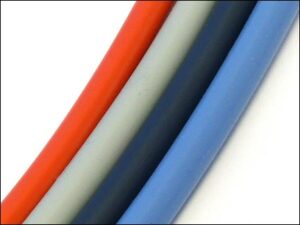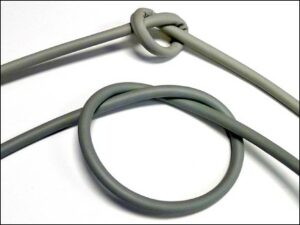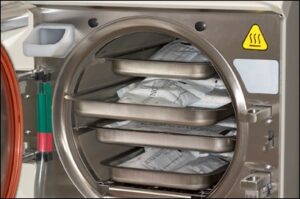Protecting Medical Device Assets with the Right Cable Jacket
6 Reasons Why You Should Take Cable Jacket Materials Into Consideration During Your Design Process
Imagine you love snowball fights and are invited by your closest friends to play on a cold snowy day in Minnesota with temperatures approaching 0 degrees Fahrenheit. You could wrap yourself up in your warmest blanket, but then you’ll be restricted in performing your killer underhand snowball throw. Or, you could stuff yourself inside an insolated box that would quickly deteriorate against the elements of wet snow. All joking aside, it’s more than likely you’ll opt for a flexible down-feather stuffed jacket that will provide the agility required during a rigorous snowball fight, that also keeps you warm and resistant to the weather you’ll face. That jacket ultimately helps you achieve optimal performance within that environment and it’s why ClearPath Medical considers all materials in the design of medical devices, starting with cable jackets.

#1: It Creates the Perception of Quality
How a user perceives a cable assembly is often influenced by the tactile feel of the cable and by how flexible it is. Regardless of the quality of the internal components and construction, it is the jacket that is the most obvious indication of the quality of the product.
Cable jackets offer mechanical, chemical, and environmental protection to the conductors within the jacket, specifying the most appropriate material for the intended use is a significant design consideration.
#2: Not All Medical Grade Resins Are the Same
- PVC is one of the lowest cost cable materials. It is commonly used as cable jacket material and to insulate individual conductors. PVC offers good resistance to alcohols, most solvents, and alkalis, but is not suitable for steam sterilization by autoclave.
- TPE/TPR (Thermoplastic Elastomer or Thermoplastic Rubber) – These materials are often referred to by the trade name of Santoprene®. TPE/TPR materials have excellent chemical resistance and are suitable for cleaning and disinfection by most methods. TPE/TPE cable assemblies can generally withstand one hundred or more steam autoclave cycles.
- TPU – Thermoplastic Polyurethane offers excellent mechanical properties, including abrasion resistance and tear strength. Disadvantages of polyurethane material include poor resistance to some common cleaning agents and high temperatures, making them unsuitable for sterilization by autoclave.
- Silicone – Silicone is both very flexible and offers a very high flex life. It is the most common choice where a high number of sterilization cycles by autoclave are required. Silicone cables can also be disinfected with most common solutions. However, silicone is less durable than most other materials used for wire and cable jackets. It is easily cut and offers poor tear resistance.
#3: There’s a Difference Between Cable Flexibility vs. Flex Life
The flexibility of cable material is a different characteristic than the flex life of a cable assembly. When designing a cable assembly, it is important to understand the role of each of these characteristics and how they apply to the intended use.
A long flex life, that is a high number of flex cycles before failure, is commonly a critical characteristic for cables that will be used for an extended period. High flexibility is a characteristic that allows a cable to be bent to a small radius without a reduction in performance or damage to the cable. For some applications, both characteristics may be necessary.
The cable jacket plays a more significant role in determining cable flexibility than cable flex life.
#4: Cable Jackets can Define Durability and Flexibility
Most materials used for wire and cable jackets are available in different degrees of hardness. A softer grade of a specific material will be more flexible than a harder grade. However, there is a trade-off in that softer (lower durometer) grades are typically less durable than harder (higher durometer) grades.
Besides the durometer, the wall thickness of the cable jacket plays a significant role in flexibility, durability, and service life. A thinner cable jacket of the same material will be more flexible and typically less durable than a cable jacket with greater wall thickness.

#5: Medical Cable Assemblies Need to Withstand Cleaning, Disinfection and Sterilization
Materials used in medical cables that may come in contact with the body also need to meet FDA and ISO biocompatibility and cytotoxicity requirements.
Whether a cable will be cleaned, disinfected, or sterilized is an important consideration when specifying cable jacket material. All common medical cable jacket materials can be cleaned and disinfected using green soap, a 10% bleach solution, or a 2% glutaraldehyde solution.
Because they are commonly found in healthcare facilities, cables are often cleaned with wipes saturated with quaternary ammonium compounds designed to be used on “hard, non-porous surfaces.” With continued use, these cleaning agents will degrade plastics, including cable and wire jackets, leading to shortened service life. Common trade names of wipes designed to disinfect hard surfaces are “CaviWipes” and “Sani-Cloth.”
#6: The Cable Construction Protects Precious Internal Components
The cable jacket covers the conductors and other components, protecting them from damage and providing a user interface. In addition to the previous discussion of material used to jacket the cabled conductors, how the cable jacket is applied to the components affects flexibility.
Extruding resin directly onto the cabled components is by far the most common method of jacketing cables. During this process, resin comes in direct contact with the cabled components filling the naturally occurring voids and forming a physical bond, which makes the cable somewhat less flexible.
If greater flexibility is required a very small gap between the inner wall of the cable jacket and the cabled components may be desirable. One method to achieve this is to extrude the jacket with an air gap between the jacket and components. Not all cable manufacturers have the capability to extrude a cable jacket with an air gap.
Another method is to use a pre-extruded cable jacket, referred to as “tubing.” Tubing is typically done on shorter lengths of cable and involves pulling the cabled components into the pre-formed tube. By leaving a small gap between the cable jacket, the inner bundle of conductors can move independently from the cable jacket, which increases flexibility.
Summary
The team at ClearPath Medical has the experience and expertise to help you select the most appropriate cable jacket material for your critical application that is sure to give your team the advantage in delivering winning medical device products to your users (but maybe not snowball fights!). Leverage ClearPath Medical’s expertise in medical cable assemblies when developing your next cable project. Get in touch!
If you’re curious about the markets they serve, download ClearPath Medical’s latest Solution Brief.
Thanks for reading!
Hank Mancini
Hank is a cable assembly ambassador and guest author on ClearPath Medical’s blog. He has more than 20 years of experience in manufacturing with a focus on medical devices leading up to his recent retirement. He's passionate about everything medical cable assembly related, along with the Dodgers, Lakers and taking his brood of grandchildren to Disneyland.


